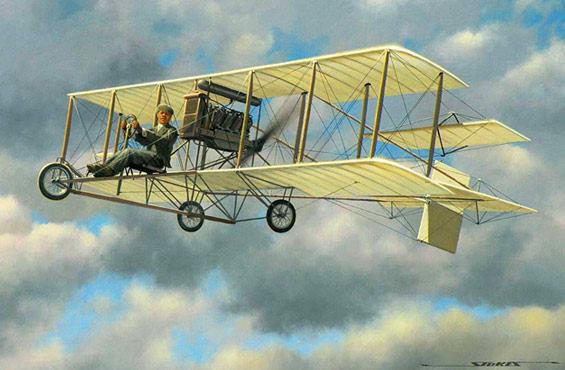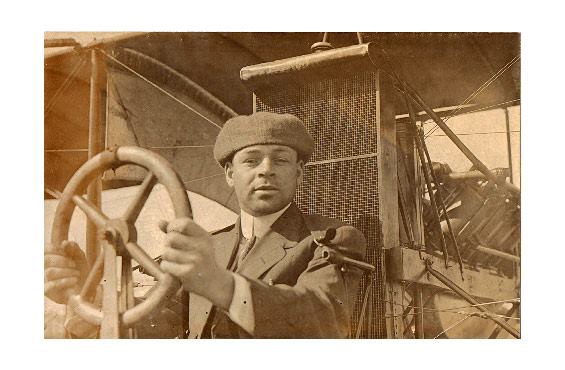The descendant of the first ever licensed African American aviator spoke to the Northeast Philadelphia History Network.

Emory Conrad Malick will most likely not be one of the first names the average person associates with airplanes, but it should be.
In honor of Black History Month, last Wednesday, the Northeast Philadelphia History Network spent its monthly meeting focusing on learning about the life and career of aviator Emory Conrad Malick.
Mary Groce, great-niece of Malick, was the guest who delivered the presentation on the life of her beloved “Uncle Emory.”
Malick, born on Dec. 29, 1881 (died 1958), grew up in Central Pennsylvania, first in Seven Points, then in nearby Sunbury, Northumberland County. He was the first licensed African-American aviator, earning his International Pilot’s License (Federation Aeronautique Internationale, or F.A.I. license), #105, on March 20, 1912, while attending the Curtiss School of Aviation on North Island, San Diego, California. He was also the first African-American pilot to earn his Federal Airline Transport License, #1716, in 1927.
Despite the historic nature of Malick’s career, many do not know his story, but Groce is trying to change that.
It was only about a dozen years ago, Groce said, that she found out about her “Uncle Emory.” She recalled her cousins’ attic having dozens of boxes that she had inherited and, while rifling through them, finding out a bit about Malick. Not many in her family talked about the career of her uncle, so she took it upon herself to learn more about this man she was just finding out about.
Groce cited the careers of African-American aviators Eugene Bullard, Bessie Coleman, James Herman Banning and Charles Alfred “Chief” Anderson as being well documented and wants to ensure her uncle’s name is remembered among these other pioneers of aviation.
“This has been a real journey that’s taken me all over the country trying to piece this puzzle together,” said Groce.
In her quest for information about Malick’s career, it has certainly been a time-consuming adventure, but it has been rewarding thus far.
She was able to find out that her “Uncle Emory” was a sort of a jack of all trades. In addition to being an aviator, she found out through the 1910 U.S. Federal Census that Malick had been a carpenter living and working in Lancaster and Philadelphia. Malick later went on to become an airplane mechanic and master tile-layer, and also worked in aerial photography with the Aero Service Corporation and Dallin Aerial Surveys.
Some may say this long and historic journey began on July 24, 1911, when he made his first recorded flight in an engine-powered “aeroplane,” which took place in Seven Points, Pennsylvania. Other remarkable days in his career were his flights on Sept. 5 and 7, 1912, when he flew his biplane to celebrate Labor Day near Shamokin, Pennsylvania.
Although he was a very skilled aviator, this did not mean his career was just smooth sailing. There were multiple occasions in which his planes had crashed in the beginning of his career, but this did not deter him for persisting in this relatively brand new industry.

Malick’s career would eventually take him to live in Philadelphia. When he moved to Philadelphia, he lived in multiple different locations, specifically around the Philadelphia Museum of Art. Malick ended up meeting Ernie Buehl, German aviator, in Philadelphia and would fly out of different airfields together. Malick and Buehl transported passengers for their “Flying Dutchman Air Service.”
Buehl was well known for flying in Northeast Philadelphia, but it is not confirmed if Malick ever took flight in the Northeast.
“I don’t know for sure if Emory was part of flying up here or not,” said Groce, but “he and Ernie Buehl were neighbors on Green Street.”
Malick stopped flying for good in 1928, after a plane accident. Despite calling it quits after that specific accident, it was still known by his peers at the time how remarkable of an aviator he was.
Groce discussed a historic ride that took place between Chief Anderson and Eleanor Roosevelt. The first lady was advised not to fly with Anderson in part because he was an African-American, said Groce, but this did not deter Roosevelt accompanying Anderson for a 40-minute flight. Groce was in contact with Anderson’s granddaughter, who had relayed the message of an interview Chief Anderson had conducted with a news outlet and was asked if he was the first licensed African-American pilot, but he told them, “No, it was Malick.”
Groce is still in pursuit of more information about her “Uncle Emory” and hopes to continue to spread the awareness of his historic career. ••




